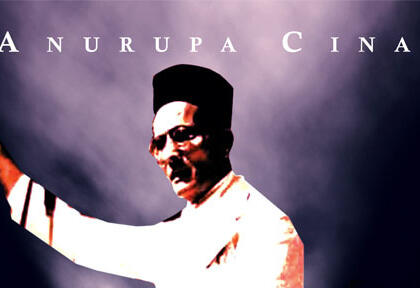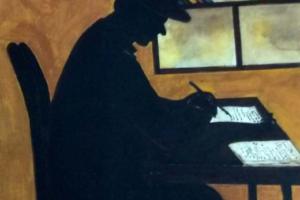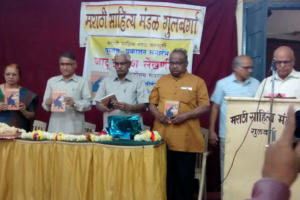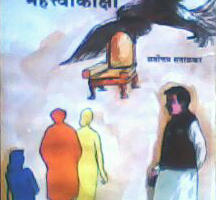- About Us
- Contact Us
- All Posts
- Archive
- Site Map
- Blog
- Stay Connected
- Latest Posts in RSS
- Dhyanyogam : ध्यानयोगम्
- अग्रलेख
- अथर्ववेद
- अध्यात्मिक
- अन्वयार्थ : तरुण विजय
- अमेरिका
- अर्थ
- आंतरराष्ट्रीय
- आंध्र प्रदेश-तेलंगणा
- आफ्रिका
- आरोग्यवर्धिनी
- आशिया
- आसाम-ईशान्य भारत
- इतस्ततः
- उ.महाराष्ट्र
- उत्तर प्रदेश
- उपनिषद्
- ऋग्वेद
- ऑस्ट्रेलिया
- ओडिशा
- कर्नाटक
- कला भारती
- किशोर भारती
- कृषी भारती
- केरळ
- क्रीडा
- गुजरात
- गुन्हे-न्याय
- गोवा
- चंदेरी
- चौफेर : अमर पुराणिक
- छायादालन
- जम्मू काश्मीर-लद्दाख
- ज्योतिष विज्ञान
- ठळक बातम्या
- तामिळनाडू
- दिल्ली
- धर्म शास्त्र
- नागरी
- प.महाराष्ट्र
- पंजाब-हरयाणा
- परराष्ट्र
- पर्यटन
- पश्चिम बंगाल
- पुराण
- फिचर
- बिहार-झारखंड
- मंत्र शास्त्र
- मध्य प्रदेश-छत्तीसगड
- मराठवाडा
- महाराष्ट्र
- मुंबई-कोकण
- मुस्लीम जगत : मुजफ्फर हुसैन
- यजुर्वेद
- युरोप
- युवा भारती
- रा. स्व. संघ
- राजकीय
- राजस्थान
- राज्य
- राष्ट्रीय
- रुचिरा
- वाणिज्य
- विज्ञान भारती
- विज्ञान-तंत्रज्ञान
- विदर्भ
- विविधा
- वेद
- व्हिडीओदालन
- सखी
- संपादकीय
- संरक्षण
- संवाद
- संसद
- सामवेद
- साहित्य
- सेवाभारती
- सोलापूर
- स्तंभलेखक
- हिमाचल प्रदेश-उत्तराखंड
- Latest Comments in RSS
- Subscribe by e-mail
- Latest Posts in RSS
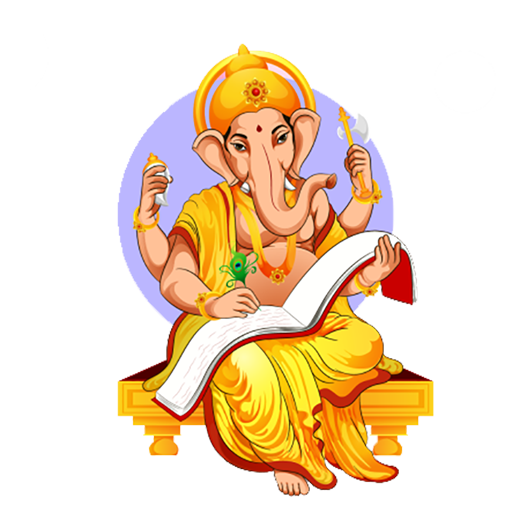
किमान तापमान : 24.74° से.
कमाल तापमान : 24.99° से.
तापमान विवरण : broken clouds
आद्रता : 53 %
वायू वेग : 5.97 मी. प्रतिसेकंद
स्थळ : Mumbai, IN
24.99° से.

23.55°से. - 26.39°से.
गुरुवार, 23 जानेवारी छितरे हुए बादल
छितरे हुए बादल 23.37°से. - 26.92°से.
शुक्रवार, 24 जानेवारी साफ आकाश
साफ आकाश 25.18°से. - 27.4°से.
शनिवार, 25 जानेवारी साफ आकाश
साफ आकाश 25.63°से. - 27.91°से.
रविवार, 26 जानेवारी साफ आकाश
साफ आकाश 25.66°से. - 27.88°से.
सोमवार, 27 जानेवारी घनघोर बादल
घनघोर बादल 25.01°से. - 27.35°से.
मंगळवार, 28 जानेवारी टूटे हुए बादल
टूटे हुए बादल SAVARKAR: THE GREAT ESCAPE 1
Thursday, July 18th, 2013SAVARKAR: THE GREAT ESCAPE Part I
This article is dedicated to:
Dr. Arvind Godbole To my everlasting regret, I was not able do the research and write this article before the passing away of Dr. Arvind Godbole, who meant more to me than can possibly be put in words.
ANURUPA CINAR
… … … … … … … … …
Introduction On July 8, 1910, in the early morning, Vinayak Damodar Savarkar, who was in British custody, escaped from the toilet porthole of the SS Morea docked in the Mole C at Marseilles port, France, and reached French soil.
With this one act he shook the world! This was a shining beacon for the freedom movement of India. This was a crushing blow to the pride of the British Raj. This is what legends are made of.
Like any legend, Savarkar’s heroic escape is cloaked in mystery and shrouded by the mists of time. Fortunately, in today’s world of technology, and thanks to the meticulous records maintained by the British, the books preserved by the U.S. libraries, and the inter-library loan service offered by the Watertown Public Library (my local library), it has been possible to blow away the cobwebs and reveal the truth of this daring, dynamic escape.
The British secret files, the British Savarkar Case and the French Savarkar Case preserve the statements of the key participants (excepting Savarkar’s) in this drama. It is painfully obvious that a regard for truth has not been a priority for any of them. Each one has given various renditions of the same event; none match the other entirely. Savarkar himself, unfortunately, has not left behind an account of his escape. His words do survive through his biography Life of Barrister Savarkar, written by Chitragupta (and purported to be written by Savarkar himself), accounts in the French newspapers, and meager references in the French and British Cases.
By a careful study of all these, the layout of the SS Morea, and the harbor at Marseilles, I have put together the events of that fateful day and am presenting them here along with illustrations.
 Titbit: The SS Morea criss-crossed Savarkar’s path twice in his life. Once, when it took him to India to face the two trials that sentenced him to 50 years in Andaman. And again, in the World War I when the SS Morea tried to vanquish the Emdem, the German cruiser sent to free Savarkar from Andaman.
Titbit: The SS Morea criss-crossed Savarkar’s path twice in his life. Once, when it took him to India to face the two trials that sentenced him to 50 years in Andaman. And again, in the World War I when the SS Morea tried to vanquish the Emdem, the German cruiser sent to free Savarkar from Andaman.
——————-
Background Vinayak Damodar Savarkar (May 28, 1883-February 26, 1966) was the intrepid and resourceful leader of the revolutionaries fighting to free India from the clutches of the British Empire. The British had expended considerable energy and ingenuity in contriving to a get a warrant issued by the Government of India to extradite Savarkar from Britain to India in order to face trumped up charges there. The charge of abetment of murder was the most serious one of them all, for it had grave implications in international law. This charge could disqualify Savarkar from being a ‘political prisoner.’ History stands testimony to the fact, that to execute this unjust warrant, the Courts in London violated the sanctity of truth and justice and delivered Savarkar into the hands of the Government of India. The SS Morea, the ship taking Savarkar to India, was to dock at Marseilles, France. This created a diplomatic situation. The British government was required to inform the French government, through diplomatic channels, of Savarkar’s presence aboard the SS Morea.
In fact, the British government needed to get an extradition order from the French government in order to take Savarkar through French waters.
This was a principle very staunchly upheld by Britain herself. But apparently only when it was a matter of taking prisoners of other countries through British waters, for this principle was swiftly discarded when it came to taking Savarkar through French waters. The French Courts were not likely to be as blind as the British ones. There was every chance of an extradition order being refused. And so, with an utter disregard for diplomatic protocol, a mere letter written by Sir Henry, Commissioner of Police, London, to Monsieur Hennion, Chief of Police, Paris, requesting that care should be taken to prevent Indian revolutionaries in France causing trouble in Marseilles was deemed sufficient. Even in that, there was no reference made to a recapture and handing over of Savarkar in the (un)likelihood of his escaping to French soil. On July 1, 1910, the SS Morea set sail with Savarkar. Accompanying him were his official guards: Deputy Superintendent of Police, Bombay Presidency, Mr. C. J. Power, with 16 years of service in Bombay city and Mofussil Police plus experience in unusual extraditions; head constable Muhammed Siddik of the CID branch, Poona; and head constable Amarsingh Sakharamsingh, Nasik police. Amarsingh had been a member of Savarkar’s Abhinav Bharat society. He was brought to London only for the purpose of identifying Savarkar in Court. Unfortunately, the third head constable, Usman Khan, who was to be in charge of Savarkar, died on June 14, 1910, just before the Morea sailed. Amarsingh had to take over his duties. But Power was given strict instructions not to leave him alone with Savarkar at any time. Mr. Parker, Detective Inspector of Police, New Scotland Yard, London, travelled with them to aid Power. This had a double significance: 1) Parker was a representative of the British government, as opposed to Power being a representative of the Government of India—India, as a subject-nation, had no standing in France or in any international matters; and 2) Parker could speak French fluently. Both these facts could be of great value if any trouble arose in Marseilles.
Indeed, Parker was to prove invaluable to the British in orchestrating the cover-up of Savarkar’s escape. Even so, they still described him as an ‘independent’ witness in the Savarkar Case!
The Great Escape During the voyage, Savarkar, Parker, and Power shared a cabin on the Main deck. The constables slept on a hatch near the Men’s room. Savarkar was never left alone, except when using the toilet or bathroom. The constables stood guard outside the door at this time. The portholes were frequently left open. The SS Morea docked on the morning of July 7, 1910, at Mole C at 10:30 a.m. The ship being coaled, all the portholes were required to be shut. Finding the cabin stifling, Power and Parker spent a significant amount of time on deck, keeping Savarkar close by their side. They took walks on the deck, too, especially on the quay side. Perceiving that danger might come from the outside in—from the Indian revolutionaries in France—Indians, especially crew members, were forbidden from disembarking at Marseilles. Any plans Savarkar may have had of escaping in disguise were foiled. A watch was kept to prevent without-ticket Indians from entering the Morea. Monsieur Le Blais, Commissaire of Immigration, Marseilles, met with Parker and assured him that four extra guards (normally four Maritime sergeants guarded the ship, upon the Captain’s request) would be patrolling the quay to prevent any mishaps. Power and Parker were confident that every precaution had been taken to prevent mishap. It was now inconceivable to Power and Parker that Savarkar might still escape. Upon arriving at Marseilles, Savarkar had immediately demanded that he be released into the custody of the French authority. According to Britain, jurisdiction aboard any ship, even foreign ones, belonged to the country which had rights to those waters. In fact, Britain had made a big deal and fuss over this, and in the teeth of pressure from other countries, refused to sign any documents that gave up their jurisdiction over foreign ships in British waters. In Britain, the jurisdiction aboard ships was indisputably Britain’s and foreign ships transporting prisoners were required to apply for extradition or else Britain could step in and take charge of the prisoner! Savarkar knew this well.
Unfortunately, the French Government did not insist on exercising their jurisdiction aboard foreign ships in their waters. As far as they were concerned, their jurisdiction only began as soon as any person was off the ship.
Savarkar was not allowed to meet Monsieur Le Blais. But he was not deterred. His resourcefulness and determination knew no bounds. During the walks on deck, he carefully studied the lay of the land. The Men’s room was on the quay side and all the toilets had portholes. Previously, he had measured the porthole of his toilet with his janeyu—13” diameter, a tight squeeze, but the only way out!
Plan of Harbor at Mole C, Marseilles @SS Morea shown in red, alongside the quay. @red line: tram lines @black lines: l’Estaque line. @Bassin de Radoud: dry docks @Thick black bars: sheds.
In the words of Savarkar’s biographer Chitragupta (purported to be Savarkar himself): “Mr. Savarkar had weighed all the consequences of an attempt to escape in his mind. He knew that failure was almost certain under these most unfavorable and hostile circumstances. . . . And if failure was almost certain how terrible would be the consequences! He had read harrowing accounts of the cruelty that these very officers were capable of when in their calmer moods. To what demoniacal fury and tortures would they not subject him if thus they got exasperated by his attempt to break off from their custody? Then any such attempt was bound to lay him open to far more serious charges and was bound to prejudice his first case in a most damaging way. For as the case stood there could have been no substantial documentary or other reliable evidence strong enough to sustain all the charges against Mr. Savarkar, so cleverly had he worked throughout that otherwise reckless agitation. Even the best legal opinions, in spite of the confessions of his former comrades that were wrung out by the Police in India, were one on the point that if he chose to defend and if no further complications took place he could not get more than seven years or so in any ordinary conducted trial. But an attempt at such daring escape would doubtless furnish that much dreaded complication. Yes: true it was that thus the price of failure would be most exacting. But if it succeeds? Succeeds even partially? What grand tradition of heroic fortitude would it not leave behind to raise the prestige of the Indian revolutionist party in the esteem of all mankind? It will take Europe by surprise. It will wash away the stigma that the leader of Abhinava Bharat was trapped by the Government as easily as one would trap a mouse. No! His arrest must cost them much more than the arrest of any single private individual had ever done. It must tax the utmost ingenuity of the English Government and force them to stand mortified and humiliated before all Europe. If no help, well he would individually do it at any rate. It was worth risking worth doing. Failure or success, he will have the satisfaction of having played his own of Indian Independence. But if, in pursuit and hunt, they shoot? Well, it would be far more in keeping with his position as the president of the Abhinava Bharat, the leader of young Indian, to die in that fashion, to get shot in the struggle than to live to rot in the Andamanese dungeons or end his life on the gallows. He must risk. But the steamer was to sail just after day break. These guards are all closing and tightly pressing on both sides. Still, if at all, this is the time. Now or never!
He actually repeated to his mind “Now or never!” Such were the thoughts running through the mind of this amazing man! He made attempts to escape in the evening of the 7th, but failed. He requested a bath at night, but unfortunately, was given an interior bathroom without a porthole. He could now only wait for the morning. The Morea was set to sail the next morning, he still had one chance: the early morning nature’s call.
Plan of the SS Morea Docked at Mole C
 (at height 30′ above the water, 21′ above the quay) @pink box: cabin of Savarkar, Power, and Parker @ brown is the quay
(at height 30′ above the water, 21′ above the quay) @pink box: cabin of Savarkar, Power, and Parker @ brown is the quay
@blue is the sea water @green is the #2 W.C. inside the Men’s restroom @gray is the disembarking ramp @ quay level @center staircase goes up to dining room-spar deck @second staircase goes to disembarking ramp deck @ dotted line is outline of spar deck above.
Plan of the SS Morea Docked at Mole C<br />(at height 30′ above the water, 21′ above the quay)
The next morning at 6:15 a.m., before the daily routine of the Morea commenced, Savarkar asked for permission to use the toilet. Power told him to wait awhile and rolled back to sleep. Fifteen minutes later, Savarkar asked again—it was imperative that he get to the toilet. This time Parker obliged. Savarkar walked ahead of Parker. The head constables slept on a hatch right outside the toilet block, but were at this time by their kit boxes further down the passage. Their view of Savarkar and Parker was obscured by the projecting wall of the toilet block. Parker lead Savarkar inside the toilet block to the W.C. # 2. Savarkar quickly slipped in and shut the door. Parker did not object. Savarkar bolted the door silently and hung his bathrobe—one gifted to him by Prince Kropotkin—on the hook over the glass panel, obscuring the view of anyone peeping in.
Plan of SS Morea showing positions of all parties:  When Savarkar enters the Men’s room. @ red dot: Savarkar @green dots: Indian constables @blue dot: Parker @gray dot: Power
When Savarkar enters the Men’s room. @ red dot: Savarkar @green dots: Indian constables @blue dot: Parker @gray dot: Power
.
Parker stepped outside to beckon the constables and then entered the toilet block again, probably to use the urinal. Amarsingh, who was dressed, started off toward the cabin (the normal practice was for the head constables to pick up Savarkar from the cabins) going beyond the toilet block, being unaware that Savarkar was actually in there at the moment. Parker stepped out again, and seeing Amarsingh down the passage, whistled to get his attention. Amarsingh turned back. Parker jerked his thumb toward the W.C. # 2 saying “He is there” and indicated that Amarsingh take his on-guard position on the platform before the urinals in front of the W.C. # 2. Parker then left the restroom, even though Muhammed Siddik had not yet arrived there.
Plan of SS Morea showing positions of all parties:  When Savarkar is half in half out of the porthole. red dot: Savarkar green dots: Indian constables blue dot: Parker gray dot: Power
When Savarkar is half in half out of the porthole. red dot: Savarkar green dots: Indian constables blue dot: Parker gray dot: Power
.
Amarsingh peeped under the door of the W.C. and saw Savarkar’s slippers before the toilet. He then peeped over the door, a normal practice for keeping an eye on Savarkar. To his horror he saw Savarkar half in-half out of the porthole. He started shouting and tried to open the door, but the bolt held. He smashed the glass panel, brushed aside the bathrobe, and saw Savarkar’s disappearing body. At this moment Siddik entered the bathroom (Parker should definitely have been in a position to hear Amarsingh’s shouts, he says so himself in his report. But in all versions of his account he stoutly denies having heard anything. Yet no one, not the British nor the French nor indeed the Hague arbitrators question his veracity.)
Plan of SS Morea showing positions of all parties:  When Savarkar just falls out of the porthole. @ red dot: Savarkar @ green dots: Indian constables @blue dot: Parker @ gray dot: Power
When Savarkar just falls out of the porthole. @ red dot: Savarkar @ green dots: Indian constables @blue dot: Parker @ gray dot: Power
.
The laxity in the morning ritual had worked in Savarkar’s favor. Putting aside his glasses (my conjecture), he had climbed on top of the toilet and pulled himself up to the porthole. Wriggling out of the tiny porthole, with nothing to brace himself against but the blank wall of the ship, must have been excruciatingly painful. At the point where the W.C. # 2 was located, the ship wall curved away from the quay by about 7′. How ominous it must have appeared to Savarkar as he dangled out of the porthole, at a thirty-foot height above that narrow strip of water.
How close was the quay wall! Would he fall onto the quay instead of in the water? How deep was the water? Would he strike his head at the bottom? Could he hold his breath long enough to turn and rise up? What was the best position to minimize the impact of the water? Could he manage to maneuver his body into that position?
Had such thoughts passed through Savarkar’s mind? Impossible to say; impossible to make a guess at the mind of so daring a man, who carried out this desperate, brilliant escape plan—knowing the negligible chances of success, knowing the dire, dire consequences of failure—and pulled it off against all odds! To be discovered half in-half out of the porthole, and still keep his cool and continue . . . ! Into that very narrow, triangular strip of water Savarkar had plunged. As soon as he was free-falling out of the porthole, he was in French jurisdiction. He had made it!
Section A-A through the SS Morea showing four positions of Savarkar’s fall into the water
At this juncture, accounts of all the guards—even in their sworn statements—enter the Realm of Implausible. According to the head constables they immediately rushed up to the spar deck, saw Savarkar running 20 paces off the quay, and ran down the ramp to give chase. Power and Parker remained uninformed and clueless of this tremendous calamity that had befallen them. There are some serious problems with this scenario that the British official report paints: @The spar deck was right above, the staircase close by. Is it possible that Savarkar could have dived into the water, swam, climbed up the nine-foot sheer wall and run 20 paces in the time it took the constables to go up one flight of steps to the Spar deck? @ The British had trained their police to follow orders, not take initiative—the success of the British Raj had depended on this. Would the Indian constables have taken such initiative and rushed off on French soil, where they had no jurisdiction, and could not speak the language? @ Would they not have, instead, rushed to their superiors with the tale? @ Would not Parker, the only French-speaking one among them, White, and from the British government body, have been the logical one to chase after Savarkar? @ Parker had lied to his superiors in Britain from the word go (the officials admit to it in the secret papers). He had submitted a carefully doctored account initially, deleting all mention of the participation of even the head constables; that reveals his familiarity with the international consequences of Savarkar’s escape. Had the matter not been made public, this account would have stood unchallenged.
Below is the more likely scenario:
The two constables rushed to the cabins of their superiors to tell this tale of horror. (The restrictions placed on Indians disembarking in Marseilles would have prevented them from being allowed to leave the ramp. Plus, who would have recognized the authority of native constables in France? None!
Plan of SS Morea showing positions of all parties:  When Savarkar is swimming toward the end quay wall. @ red dot: Savarkar @ green dots: Indian constables @ blue dot: Parker @ gray dot: Power
When Savarkar is swimming toward the end quay wall. @ red dot: Savarkar @ green dots: Indian constables @ blue dot: Parker @ gray dot: Power
.
Savarkar was free of British jurisdiction from the moment he was free-falling out of the Morea! Both Power and Parker were most certainly aware of that—Power with experience in foreign extraditions and Parker, a Scotland Yard officer (whose jurisdiction was surely limited to Britain, if not London, only) must have known the extent of their jurisdiction! What should be done? This was the question that loomed large. Even now, all was not lost, for surely from the water Savarkar had no place to go? The sheer quay wall was nine-foot high. How could he get to the top? The question was how to get him out of the water and back on the ship, really. Power dressed, and all four went on the deck to see how Savarkar was floundering around in the water. The lifeboats and the ladders to climb down were accessed from the deck. And so was the Bridge (to get the Captain’s permission). This is why they went up to the deck, rather than down to the ramp—they had no expectation that Savarkar would actually climb the wall and reach safety!
It is around this time that the last crucial character, Sergeant Pesquie, of the Marseilles Maritime police, entered the scene. His official story leaves much to be desired. He claimed that he saw Savarkar jump from the porthole—and yet he was not there to greet Savarkar at the top of the quay wall when he climbed out. Strange!
Another odd point is that out of the eight Maritime police, only Sergeant Pesquie appears to have been present that morning. Where were the others? The answer is perhaps in the French documents, which I have not been able to access.
Pesquie’s beat had, perhaps, taken him to the other end of the Morea, which was 540′ long, and maybe he had his back turned toward Savarkar’s porthole as well. It is unlikely he actually saw Savarkar jump, for he would surely have taken some action.
Plan of SS Morea showing positions of all parties:  When Savarkar climbs out on the quay wall. red dot: Savarkar green dots: Indian constables blue dot: Parker gray dot: Power teal dot: Pesquie (to the right on the quay)
When Savarkar climbs out on the quay wall. red dot: Savarkar green dots: Indian constables blue dot: Parker gray dot: Power teal dot: Pesquie (to the right on the quay)
. It was a miracle Savarkar survived the dive. Abhinav Bharat members were required to be proficient in swimming and climbing, and Savarkar was a powerful swimmer. It is doubtful if he had experience of free-fall high dives.
The impact of the water could have broken bones, shattered internal organs. The turning radius for a return dive is at least 4′; he could have easily crashed into the quay wall, or the wall of the Morea! The 28′ 3” depth of the water must have been like a narrow, dark tunnel. He had to turn before he hit the bottom. Was the bottom visible through the dark water? Could he keep his eyes open during the dive to see it? Did the salt water make his eyes smart? Turning too early would have damaged his body. He also had to surface before running out of air.
Despite all these potential problems, Savarkar had made it! He touched the quay wall—the French soil—with his flat palm. There! Now he had a right to claim asylum in France. Then he swam toward the end quay wall.
Having studied the lay of the land, Savarkar must have known that the shortest way out to the street was at the corner where the quay walls met. There was a break in the shed buildings right there. Breaking out of the water, after the dive, he was much too close to the ramp. It was much wiser to swim to that point and climb the wall there. He would surely have been more invisible swimming in the water, than running on the quay.
 Reaching the end quay wall Savarkar proceeded to climb out. Once he fell back in, but he resolutely carried on trying. Then he was on the quay, but not safe. Not daring to stop and catch his breath, he ran.
Reaching the end quay wall Savarkar proceeded to climb out. Once he fell back in, but he resolutely carried on trying. Then he was on the quay, but not safe. Not daring to stop and catch his breath, he ran.
What strength it must have taken to pull himself out of the water, with nothing to hold on to! To climb out clinging to the grooves made by the grouting . . . !
His guards, by now out in the Spar deck spotted him running. What a calamity! The hoops the British had jumped through in order to extradite Savarkar to India, and there he was running free. By hook or by crook it had to be prevented, so determined his guards.
Plan of SS Morea showing positions of all parties:  When Savarkar runs out on the quay. @ red dot: Savarkar @ green dots: Indian constables @ blue dot: Parker @ gray dot: Power @ teal dot: Pesquie (to the right on the quay)
When Savarkar runs out on the quay. @ red dot: Savarkar @ green dots: Indian constables @ blue dot: Parker @ gray dot: Power @ teal dot: Pesquie (to the right on the quay)
.
Savarkar’s horror-stricken guards started yelling, “Stop him! Stop thief!” Some of the deck-hands joined in. Amarsingh, Siddik and Parker headed for the staircase to the exit ramp.
Parker had to go ashore. He knew French and had the authority to go ashore as well. The French police were hardly likely to listen to native constables, besides. Power and the crew members continued the clamor on the deck.
At this time, Pesquie was close enough to hear the shouts of “Stop thief! Stop him!” coming from the deck. He spotted Savarkar taking off and ran after him immediately (this is how Savarkar was first, then Pesquie, followed by the guards in the chase that followed). Parker, Siddik, Slavin (Head Saloon Steward), and Amarsingh ran out to the quay in that order. The desperate chase was on. They were still yelling “stop, thief!” and dock-workers were beginning to take interest. Savarkar ran for his life, across the tramway lines and further, calling out for the police. On the road beyond the end of the dry dock, some dock-workers stopped him, and pointed out to Pesquie running behind.
Perhaps, Savarkar did not have his glasses (it could have been tricky business to dive with them, even tied to his janeyu) for he had not noticed (assuming he looked back to check he was being chased) that it was a French maritime police running behind him.
 Savarkar turned back and went to Pesquie himself. He asked Pesquie to take him to the Magistrate. In effect, he had surrendered himself to the French authority in French jurisdiction. But Pesquie did not understand his words. Red dotted lines shows Savarkar’s escape route, and turn back point.
Savarkar turned back and went to Pesquie himself. He asked Pesquie to take him to the Magistrate. In effect, he had surrendered himself to the French authority in French jurisdiction. But Pesquie did not understand his words. Red dotted lines shows Savarkar’s escape route, and turn back point.
By this time Parker and company reached there. Parker, the only one who could speak French and White, as well, convinced (bribed? According to the Chitragupta account he was bribed) Pesquie to take Savarkar back to the Morea. Here Parker reveals by his actions an awareness of the fact that Pesquie had to come with them, for Parker himself had no authority to whisk Savarkar off the French soil.
On an aside: did Pesquie himself, as a maritime sergeant and not a policeman, have the authority to make a civilian arrest? He had the authority to arrest deserters—but perhaps, only deserters? And Savarkar was certainly not a deserter. What was the extent of the authority of the Maritime police? I have not yet been able to determine this point, and it does not (though it should) come up in the Savarkar Case anywhere.
A mere appearance of the ‘right’ thing had to be maintained. Pesquie’s physical presence beside Savarkar was just enough for Parker to claim in the doctored report he sent to his superiors in Britain that “a French policeman arrested Savarkar after his escape and brought him back aboard.” Parker himself did not touch Savarkar as they went back toward the ship. One constable grabbed Savarkar by the scruff of his neck, other by the left wrist, and Slavin by the right arm. Pesquie grabbed Savarkar’s right wrist (also, probably, as instructed by Parker, for otherwise what need was there? For Parker, it was essential that Pesquie appear to be the one taking Savarkar.) Savarkar protested and struggled vigorously all the way, still asking to be taken to a magistrate.
Amarsingh, Siddik, and Pesquie all claim that Savarkar came ‘meekly’ with them to the Morea. This is a preposterous statement! Can the word ‘meek’ be associated with Savarkar—a man with the daring and guts to execute successfully this impossible, improbable escape? Would such a man go ‘meekly’ toward the horrendous fate that awaited him aboard the Morea and in India? Would he not struggle against this kidnapping?
At the gangway of the Morea, Power was there (standing safely within his jurisdiction); he took Savarkar into custody. And Pesquie left.
This is what Pesquie claims in his account (available in the French Case). Here again is revealed everyone’s awareness of their jurisdiction. Pesquie’s ends at the quay, and he does not enter the ship.
Pesquie reported this incident to his superior. Monsieur Le Blais came to the Morea to investigate the matter. He said it would have to be taken to the French police (Parker admits this in his report).
By this Le Blais, (and so should have Parker and Power, if they didn’t know before) clearly recognized that the matter was not within the jurisdiction of the maritime police. This obvious point is also not addressed in the Hague Arbitration.
In actual fact, though the Morea remained in Marseilles for another 24 hours, no action was taken, by anyone. Again, perhaps the French documents will reveal what took place in those crucial hours. In the scenario painted by Power, Parker, Amarsingh, and Siddik Pesquie brings Savarkar all the way to Power’s cabin, where Parker opens the door shaving and Power is just waking up! We are to swallow—most certainly the eminent arbitrators of the Hague appear to have swallowed it—that in all this time in the hullabaloo that must have been created, Parker and Power remained oh-so-innocently unaware of anything amiss.
At the very least the duo would have wondered why Savarkar was not back from the Men’s room, gone to investigate, and then discovered the whole!
Pesquie’s role in this travesty of justice is quite suspect too. He claims he did not recognize Savarkar as the special prisoner; all the while he believed him to be a deserter of the Morea.
Why then did he not take Savarkar to the Captain? Surely, that would be the protocol? Why let Power take him? Indeed, where was the captain when these events were taking place?
Surely it is impossible that the Captain was unaware of Savarkar’s escape! From the Bridge, the whole rumpus must have been visible. The man overboard situation itself, needed the Captain’s authority to take action. The ship’s officers must surely have alerted him immediately. Unfortunately, other than the Captain’s name, W. L. Broun, I have not been able to discover anything else.
The Indian revolutionaries in France valiantly took up Savarkar’s cause and created a lot of year-long publicity (many of the newspaper articles are extant). But Savarkar’s fate was sealed the moment he re-entered the Morea.
The tale of Savarkar’s magnificent escape has survived, despite all attempts to quash it. There is a profusion of documented proof to verify that it actually happened. And now it is revealed in all its glory.
GO TO PART 2 – SAVARKAR: THE GREAT ESCAPE PART 2
Short URL : https://vrittabharati.in/?p=6806Filed under : साहित्य
Author Description : .
You can follow any responses to this entry through the RSS 2.0
You can leave a response or trackback to this entry







